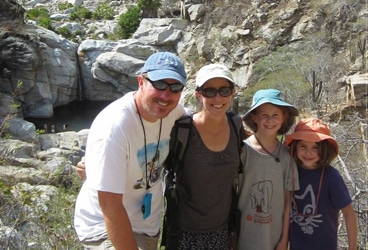
Del Viento- hike
Kids’ passports are good for five years. That’s probably quite a while when you’re paying off a new car loan, but it’s 60 short months of travel and adventure time. So here we are, in Mexico, with half of us needing new passports. The good news is that it’s easier, in some ways, to renew your U.S. passport out-of-country. The bad news is I found a way to make it harder. But then I found a way to make it better.
I took on this task by getting our ducks in a row. Since we’d be renting a car and driving three hours to the U.S. Consular Agent in San Jose del Cabo, I made sure we had all the paperwork ready (application forms, certified birth certificates, passport photos, and money), that I knew the office hours (M-F, 0730-1615), and rules (both parents must accompany minors to apply for a passport renewal—or make other difficult provisions), and the location (Shoppes at Palmilla strip mall). Then I booked our rental car.
On Monday, February 17, we got up early, secured the boat, and headed south to apply for new passports. Our goal was a quick drive down and a quick drive back. We met our first goal.
When I pulled on the doors of the U.S. Consular Agent, they wouldn’t open. Windy pointed at a small notice in the window and gave me a look. Who knew it was Presidents’ Day in the U.S.?
So it had been a hot drive in our little econobox and we were sweaty, hungry, and none of us wanted to drive six hours just to be here again the next morning. I called the car rental company to extend a day and told the girls we’d make a San Jose del Cabo vacation of it. I found a half-star motel for 500 pesos ($39), where we could shower, grudgingly put back on our dirty clothes, and wish that for some reason we’d thought to bring toothpaste and toothbrushes. Then we went to get ice cream and see_ La Ladrona de Libros_ (The Book Thief) in the theater (very good movie that prompted lots of talking points for the ride home the next day).
On Tuesday, the passport application process went smoothly. The benefit of being out-of-country is that you get almost personalized service from Consulate employees who know what they’re talking about, you don’t wait in line to get it, and you pay no more than in the States. (Though one of us will have to repeat this trip in five weeks or so to pick up the new passports.)
On the way home, things got even better. Exploring a strange side road off Highway 1, I picked up our first hitchhiker.
It’s a quick appraisal, even at the modest pace of 45 miles-per-hour, whether the dude on the side of the road you stop for is someone you want to invite into the car with your family. I don’t remember the young student’s name, but he was headed on foot down a long, straight road that appeared to us to have no end. And as I said, it was a strange road, out in the middle of nowhere but with curbs, thousands of streetlights, and a verge separating traffic that’s filled with flowering oleanders. Windy climbed in the backseat and we continued on.
It turned out our hitchhiker lived just about a mile and a half ahead, where the road ended in the small town of Santiago, population 700. He asked where we were going and I said we didn’t know, just exploring. He peered back to the rest of this odd gringo family in the backseat and smiled.
Va a sol de mayo?
“Manday.” I said, asking him to repeat.
“Va a sol de mayo?”
I looked back at Windy, “Do you get it? It sounds like he’s asking if we’re going to the sun of May, that can’t be right.”
We dropped our young passenger off in town, never getting past our communication barrier. Then we took in Santiago. It was a relief from the tourism of San Jose del Cabo and the metropolis of La Paz, a small, Mexican pueblo. It was first inhabited by Jesuit missionaries in the mid-1700s; there’s an old mission there dating back to that century. The Mexicans made it an incorporated city back in the 1800s and it used to be a stop on the long, rough road down to the tip of the Baja peninsula, before they finished Highway 1 in 1973.
Then we saw a small sign at the edge of town: “Sol de Mayo, 10 km.” We followed the arrow, slinging our econobox down a soft, narrow dirt road, stopping to read interpretive displays about where we were apparently headed. The only thing that became clear is that we were headed for an oasis of sorts, an eco-tourism destination at the foot of the Sierra de la Laguna range, a UNESCO global biosphere reserve.
Sol de Mayo is an oasis, a pool at the base of one of several waterfalls in the area that are produced from underground springs. It’s at the end of a short trailhead that begins where we parked our car. And from there, there was no hint of what lay ahead.
The trail was steep and when we finally got to Sol de Mayo it seemed more like a mirage. We again removed our sweat soaked clothes and waded in. A family of coots swam with us as we moved between the hot, smooth rocks and the cool spring water.
In our twenties, we traded our boat for a house and our freedom for careers. In our thirties, we slumbered through the American dream. In our forties, we woke and traded our house for a boat and our careers for freedom. And here we are. Follow along at logofdelviento.blogspot.com








